Thomas May's Blog, page 2
September 7, 2025
Chaya Czernowin and Claire Chase in Lucerne
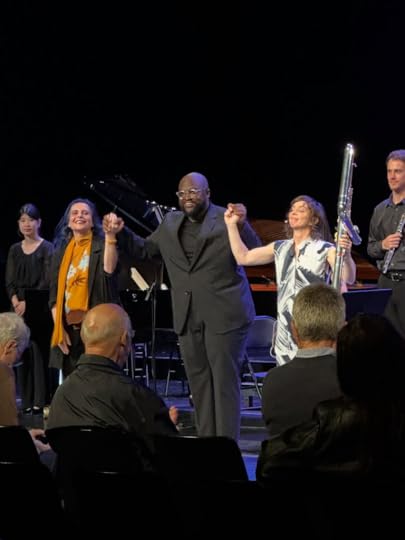
The amazing work of Lucerne Festival‘s Academy, focused on contemporary music, was on full display at Saturday morning’s concert featuring the incomparable Claire Chase, who joined members of the Lucerne Festival Contemporary Orchestra (LFCO) led by Vimbayi Kaziboni for the first Swiss performance of Chaya Czernowin‘s ‘The Divine Thawing of the Core’, which she premiered last month.
Czernowin’s gripping response to the political turmoil of the last several years in her native Israel, which she metaphorically imagines as ‘the forced thawing of a democratic society into a theocracy’ – hence the ironic title – ‘Divine Thawing’ is a substantial, 53-minute work for contrabass flute and an ensemble of six flutes, six oboes, six trumpets, trombone, tuba, percussion, piano, and three cellos. More than expressing pain, Czernowin’s astonishing score enacts it, with a devastating, claustrophobic sense of helplessness that presses on you like a physical weight. Rarely have triads sounded so terrifying.
‘It is a very elemental, naked and maybe an intimate beginning,’ remarks the composer, ‘which is forced to melt away through irony into an elemental brutality, in an uneven process, which includes a demonic waltz, in a gradual thawing of its features into a kind of a wholly different way of expression which is more coherent, ceremonial and brutally primitive.’
Chase’s contrabass flute anchored ‘Divine Thawing’ with an uncanny blend of ferocity and vulnerability. With her intense breaths woven into the texture, she seemed to live every extreme of Czernowin’s score, conveying its sense of struggle and resistance and raw endurance. A stunning performance.
Czernowin’s work also reflects her deep admiration of Galina Ustvolskaya‘s Symphony No. 2 from 1979 (‘True and Eternal Bliss!’), which was performed immediately preceding ‘Divine Thawing’, with Stefan Jovanovic as the reciter. The incredible originality of this music made a tremendous impact, uncompromisingly fierce, under Kaziboni’s guidance. The LFCO musicians are truly fearless.
Opening the program were the stark sonorities of Sofia Gubaidulina’s Trio for Three Trumpets from 1976, which summoned the audience into the unfamiliar terrain of the rest of the concert with a magnetic incantation.
September 5, 2025
Salonen with the Parisians in Lucerne
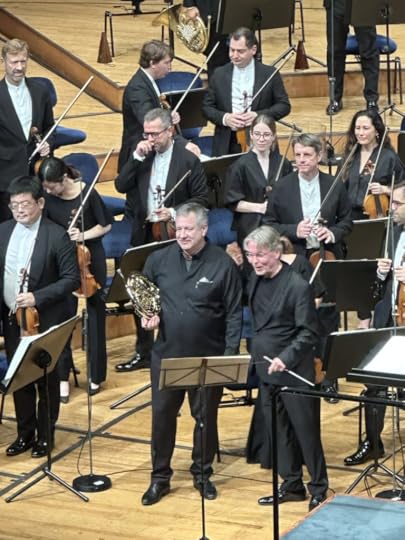
Big news this week: just after Esa-Pekka Salonen wrapped up his Lucerne Festival visit with the Orchestre de Paris, it was announced that he has been named the ensemble’s Chief Conductor starting in 2027. Parallel to that, he’ll become the take up the new Creativity and Innovation Chair of the Philharmonie de Paris. Salonen’s collaboration with the orchestra in Lucerne offered a vivid taste of that future partnership in two very different programs last weekend.
In the first, Augustin Hadelich was the soloist in an account of the Brahms concerto notable for its shadowed lyricism and spacious pacing, illuminating the score’s darker hues. Hadelich played his own cadenza and his arrangement of a Carlos Gardel tango as a steam-vent of an encore following such intensity. If Salonen brought structural clarity to the Brahms, the suite from Prokofiev’s ‘Romeo and Juliet’ that followed surged with dramatic sweep. The episodes seemed to unfold as part of an inexorable tragic arc rather than a set of contrasting miniatures.
His second evening with the Paris musicians revealed a touch more humor alongside the testosterone of ‘Don Juan’. But all that Straussian horn-iness set the stage for the much-anticipated world premiere of Salonen’s own Horn Concerto written for Berliner Philharmoniker principal Stefan Dohr. It’s a big piece, heroic in its way and abounding in the composer’s deep knowledge of the literature across music history, especially Mozart, Beethoven, and Bruckner (Salonen also trained as a horn player). He colorfully remarked that these moments from the musical past ‘appear and disappear like fish coming to the surface to catch an insect before diving to the depths of the sea again’.
The concerto teems with exposed solo passages that seem to test the limits of breath and control — not to mention imagination, indispensable to giving expressive shape to Salonen’s fertile ideas. Around the horn, the orchestra cast a kaleidoscope of refined colors. The concerto will travel widely in the coming months, so I hope to get a chance for more encounters.
Horn sounds resounded still again, sublimely, in the Sibelius Fifth. Salonen’s control of the art of transition, with subtly judged but dramatically thrilling accelerando, was a marvel. For all the monumentality of the closing chords, I fancied amid their awe an echo of mortality, like the trees being felled at the end of ‘The Cherry Orchard’. But the solace of Sibelius’s glorious Swan Theme circled in the mind’s ear as the swans on Lake Lucerne outside the KKL glided serenely by in serene silence.
September 2, 2025
The Concertgebouw Orchestra at Lucerne Festival
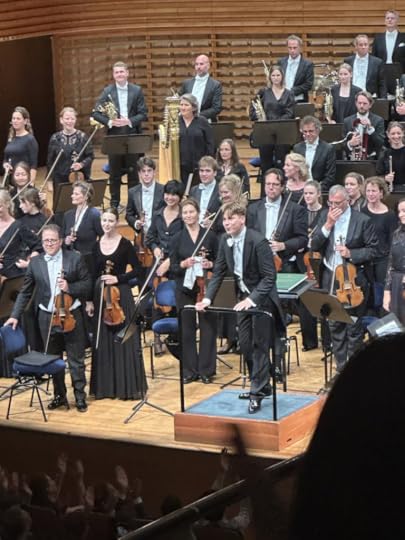
Deeply grateful for the chance to experience both Concertgebouworkest concerts at this summer’s Lucerne Festival. On the first night, Janine Jansen seemed to guide us along a silvery path into the stars with Prokofiev’s First Violin Concerto — sans the guilt of escapism from a troubled world: the effect was too transfiguring. On either side of the Concerto were
Mozart’s ‘Paris’ Symphony, scintillating with surprise, and a Concerto for Orchestra that caught the double edge of Bartók’s thinking in this last-minute artistic reprieve, the grip of its shadows yet allowing for the persistence of hope.
The second program began with Berio, in his fascinating and now seldom-heard “Rendering”, as he summoned Schubert’s friendly, curious, half-smiling ghost, without a trace of rear-view mirror parody, but neither as a holy relic drifting through fragments. The culmination was pure revelation: Mäkelä led a Mahler Fifth overwhelming in its simultaneity of detail, yet which clarified the sense of Mahler at an existential crossroads in life and art. Above all, the sheer vibrancy of the finale swept away the cranky Adorno-inspired doubts about “happy endings” (though the Seventh remains another story entirely). I really felt as if I were hearing the Fifth for the very first time. Brilliant, packed pre-concert lectures by Lucerne Festival dramaturge Susanne Stähr filled the KKL Auditorium and set the stage for each program.
August 27, 2025
Postcard from Tippet Rise
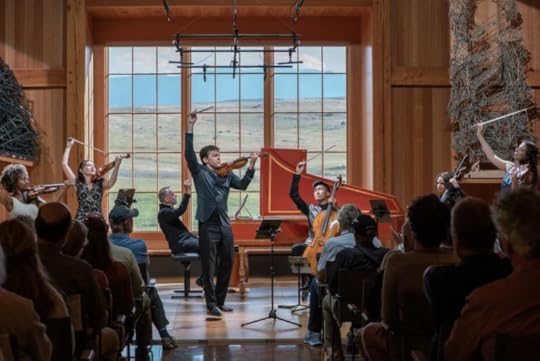 Melissa White, Isabelle Ai Durrenberger, Pedja Mužijević, Benjamin Beilman, Bryan Cheng, Lizzie Burns and Emma Wernig in The Four Seasons at the Olivier Music Barn; photo: Brian Langeliers
Melissa White, Isabelle Ai Durrenberger, Pedja Mužijević, Benjamin Beilman, Bryan Cheng, Lizzie Burns and Emma Wernig in The Four Seasons at the Olivier Music Barn; photo: Brian LangeliersI was very grateful to have the opportunity to return to Tippet Rise this summer. Here’s my report on the opening weekend of the summer season for The Strad:
From this magical spot in south-central Montana, the horizon is ringed by mountains: the Beartooths to the south, guarding the way to Yellowstone; the Absarokas to the east; and the Crazies rising in the west. The panorama shifts as quickly – and as dramatically – as the skies above. Storms can sweep across the land like Wagnerian preludes – dark, brooding, full of menace – only to dissolve moments later into shafts of unearthly light.
August 21, 2025
At the Edge of the Storm: String Quartets in a Turbulent Decade
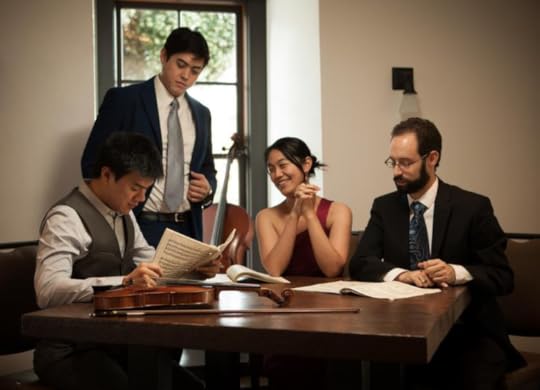 Telegraph Quartet; photo: Matthew Washburn
Telegraph Quartet; photo: Matthew WashburnOn its new album Edge of the Storm, the San Francisco-based Telegraph Quartet explores string quartets from 1941-51. My interview for The Strad:
Edge of the Storm, the new album by the Telegraph Quartet, is the second instalment in its ongoing 20th-Century Vantage Points series – a curatorial project that maps key string quartet works against the seismic historical forces of the last century. Where the first volume (Divergent Paths, 2023) explored the early modernist rupture through Ravel and Schoenberg, this new release turns to the years 1941–1951: a turbulent decade shaped by war, exile, and the search for renewal….
August 19, 2025
NYO-USA in Asia: Music beyond Borders
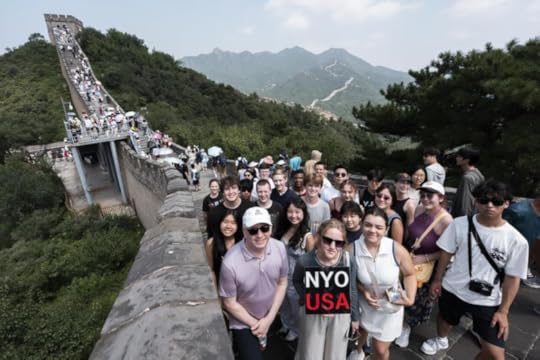 2025 NYO-USA in China; photo: Chris Lee
2025 NYO-USA in China; photo: Chris LeeThis summer, between 22 July and 6 August, the National Youth Orchestra of the USA (NYO-USA) embarked on a whirlwind six-city tour of Asia under the direction of Gianandrea Noseda. Nearly 100 of the nation’s most talented teenage musicians took part, representing 29 states and the District of Columbia….
August 14, 2025
Where Music Meets Nature
 Tessa Lark in Moab; photo: Richard Bowditch
Tessa Lark in Moab; photo: Richard BowditchPreparing to embark on her first season as artistic director of the Moab Music Festival later this month, the amazing violinist Tessa Lark spoke with me for The Strad:
When the Moab Music Festival opens its 33rd season later this month, it will mark the first change in artistic directorship since the festival’s inception, with violinist Tessa Lark taking the helm. The Kentucky-born musician combines a distinguished classical pedigree with a curiosity that spans Appalachian fiddle tunes to contemporary premieres. …
August 8, 2025
Perfect Timing: ‘Figaro’ in Santa Fe
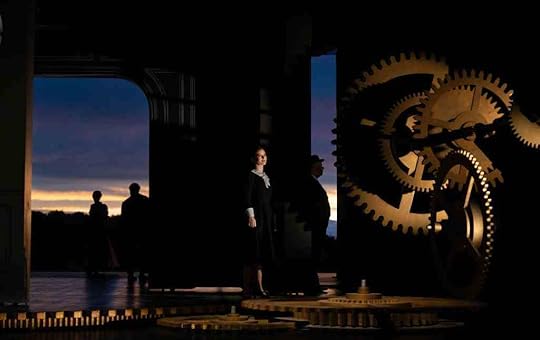 Liv Redpath as Susanna in The Marriage of Figaro at Santa Fe Opera; image: Bronwen Sharp
Liv Redpath as Susanna in The Marriage of Figaro at Santa Fe Opera; image: Bronwen SharpMy Musical America review of Laurent Pelly’s Nozze at Santa Fe Opera:
SANTA FE—The plot of The Marriage of Figaro can feel like a dizzying maze of deceptions and deferred revelations—its intricate turns threatening to overwhelm the human stakes. But in Santa Fe Opera’s ingeniously paced production, directed by Laurent Pelly, every complication slips neatly into place with the precision of a fine timepiece, allowing the machinery of the plot to bring the messy human entanglements that drive the drama into…
August 7, 2025
Across the Americas: The Miró Quartet Celebrates Alberto Ginastera
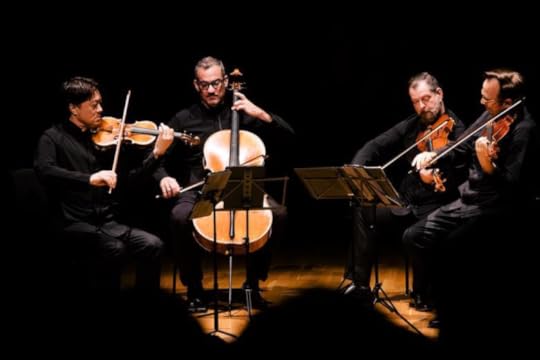 Miró Quartet: Daniel Ching, Joshua Gindele, John Largess and William Fedkenheuer
Miró Quartet: Daniel Ching, Joshua Gindele, John Largess and William FedkenheuerHere’s an interview I did for The Strad with the Miró Quartet on their new recording of the complete quartets by Alberto Ginastera:
Among the Miró Quartet’s projects marking its milestone 30th-anniversary season in 2025 is a new recording of the three string quartets by Alberto Ginastera. For the String Quartet No. 3, Miró is joined by soprano Kiera Duffy. Long a staple of the ensemble’s live repertoire, these works trace the full arc of the Argentine composer’s creative evolution. As violist John Largess notes, they synthesise Argentine folk idioms with bold modernist language, making extraordinary technical demands.
August 5, 2025
Blood Ropes and Broken Gods: ‘Die Walküre’ in Santa Fe
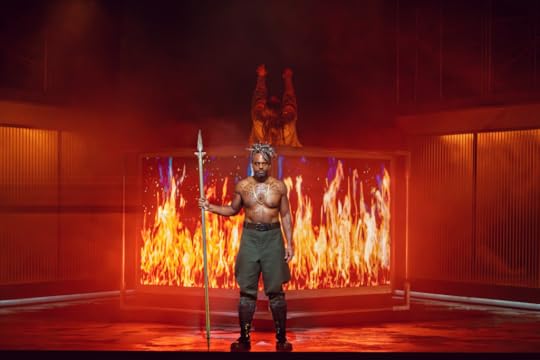 Ryan Speedo Green (Wotan), Back: Tamara Wilson (Brüunhilde), photo by Curtis Brown for the Santa Fe Opera
Ryan Speedo Green (Wotan), Back: Tamara Wilson (Brüunhilde), photo by Curtis Brown for the Santa Fe OperaNothing like seeing Die Walküre accompanied by lightning and storm clouds @Santa Fe Opera. My review for Opera Now:
As its track record of world premieres and off-the-beaten-path repertoire proves, Santa Fe Opera has never shied away from adventurous undertakings. But with this new Die Walküre—its first venture into the Ring and only its third Wagner staging since 2022—the company takes a striking step into territory long left unexplored.
Thomas May's Blog



